Day–Night Synergy Between Built Environment and Thermal Comfort and Its Impact on Pedestrian Street Vitality: Beijing–Chengdu Comparison
Abstract
1. Introduction
1.1. Climate Environment and Its Impact on Urban Vitality
1.2. The Relationship Between the Built Environment and Urban Vitality
- How do individual built environment factors influence the vitality of pedestrian commercial streets and what trends do they exhibit?
- How do the interactions among different built environment factors affect street vitality?
2. Data and Methods
2.1. Research Framework
2.2. Study Area
2.3. Data Processing and Verification
2.3.1. Independent Variables
- Shop width (SW)
- 2.
- Street width
- 3.
- Green view ratio (GVR)
- 4.
- Sky visibility
- 5.
- Number of items of street furniture
- 6.
- Physiological equivalent temperature (PET)
- 7.
- Store interface transparency (FT)
- 8.
- Billboard density
2.3.2. Dependent Variable
2.4. Interpretable Machine Learning Approach
3. Results
3.1. Spatiotemporal Dynamics of Pedestrian Commercial Street Vitality
3.2. Vitality Impact Magnitude of Individual Built Environment Factors
3.3. Synergistic Effects of Built Environment Factors on Street Vitality
4. Discussion
4.1. Diurnal and Nocturnal Effects of Built Environment Factors on Street Vitality
4.2. Differences in the Impact of Built Environment Factors on Street Vitality Across Different Cities
4.3. Limitations and Perspectives
5. Conclusions
Author Contributions
Funding
Data Availability Statement
Acknowledgments
Conflicts of Interest
References
- Ghazi, N.M.; Abaas, Z.R. Toward liveable commercial streets: A case study of Al-Karada inner street in Baghdad. Heliyon 2019, 5, e01862. [Google Scholar] [CrossRef] [PubMed]
- United Nations Human Settlements Programme (UN-Habitat). World Cities Report 2024; United Nations Human Settlements Programme: Nairobi, Kenya, 2024. [Google Scholar]
- Ji, Y.; Wang, Z.; Zhu, D. Exploring the impact of urban amenities on business circle vitality using multi-source big data. Land 2024, 13, 1616. [Google Scholar] [CrossRef]
- Xing, H.; Meng, Y. Revealing deep semantic commercial patterns: Insights from urban landscape depiction. Comput. Environ. Urban Syst. 2020, 79, 101404. [Google Scholar] [CrossRef]
- Li, X.; Li, Y.; Jia, T.; Zhou, L.; Hijazi, I.H. The six dimensions of built environment on urban vitality: Fusion evidence from multi-source data. Cities 2022, 121, 103482. [Google Scholar] [CrossRef]
- Wagner, P.; Schäfer, K. Influence of mixing layer height on air pollutant concentrations in an urban street canyon. Urban Clim. 2017, 22, 64–79. [Google Scholar] [CrossRef]
- He, B.J.; Ding, L.; Prasad, D. Enhancing urban ventilation performance through the development of precinct ventilation zones: A case study based on the Greater Sydney, Australia. Sustain. Cities Soc. 2019, 47, 101472. [Google Scholar] [CrossRef]
- Gu, X.; Wu, Z.; Liu, X.; Qiao, R.; Jiang, Q. Exploring the nonlinear interplay between urban morphology and nighttime thermal environment. Sustain. Cities Soc. 2024, 101, 105176. [Google Scholar] [CrossRef]
- Liu, Z.; Liu, C. The association between urban density and multiple health risks based on interpretable machine learning: A study of American urban communities. Cities 2024, 153, 105170. [Google Scholar] [CrossRef]
- He, J.; Shi, Y.; Xu, L.; Lu, Z.; Feng, M.; Tang, J.; Guo, X. Exploring the scale effect of urban thermal environment through XGBoost model. Sustain. Cities Soc. 2024, 114, 105763. [Google Scholar] [CrossRef]
- Weilnhammer, V.; Schmid, J.; Mittermeier, I.; Schreiber, F.; Jiang, L.; Pastuhovic, V.; Heinze, S. Extreme weather events in Europe and their health consequences–A systematic review. Int. J. Hyg. Environ. Health 2021, 233, 113688. [Google Scholar] [CrossRef]
- Han, Y.; Qin, C.; Xiao, L.; Ye, Y. The nonlinear relationships between built environment features and urban street vitality: A data-driven exploration. Environ. Plan. B Urban Anal. City Sci. 2024, 51, 195–215. [Google Scholar] [CrossRef]
- Loo, B.P.; Fan, Z. Social interaction in public space: Spatial edges, moveable furniture, and visual landmarks. Environ. Plan. B Urban Anal. City Sci. 2023, 50, 2510–2526. [Google Scholar] [CrossRef]
- Gehl, J. Life Between Buildings; Island Press: Washington, DC, USA, 2011. [Google Scholar]
- Niu, T.; Qing, L.; Han, L.; Long, Y.; Hou, J.; Li, L.; Teng, Q. Small public space vitality analysis and evaluation based on human trajectory modeling using video data. Build. Environ. 2022, 225, 109563. [Google Scholar] [CrossRef]
- Ren, Z.; Fu, Y.; Dong, Y.; Zhang, P.; He, X. Rapid urbanization and climate change significantly contribute to worsening urban human thermal comfort: A national 183-city, 26-year study in China. Urban Clim. 2022, 43, 101154. [Google Scholar] [CrossRef]
- Pu, R. Assessing scaling effect in downscaling land surface temperature in a heterogenous urban environment. Int. J. Appl. Earth Obs. Geoinf. 2021, 96, 102256. [Google Scholar] [CrossRef]
- Wang, Z.; Yang, Y.; Liu, C.; Zhou, F.; Hao, H. Human thermal comfort model and evaluation on building thermal environment. Energy Build. 2024, 323, 114796. [Google Scholar] [CrossRef]
- Li, J.; Lin, S.; Kong, N.; Ke, Y.; Zeng, J.; Chen, J. Nonlinear and synergistic effects of built environment indicators on street vitality: A case study of humid and hot urban cities. Sustainability 2024, 16, 1731. [Google Scholar] [CrossRef]
- Wu, W.; Tan, W.; Chen, W.Y.; Wang, R. Disentangling the non-linear impacts of natural attributes of urban built environment on life satisfaction. Cities 2024, 155, 105496. [Google Scholar] [CrossRef]
- Xu, J.; Xu, X.; Wang, Z.; Chen, H.; Ren, Q.; Huang, H.; Cui, Y.; An, R.; Liu, Y. Investigating thermal exposure during daily walking through a human-scale approach: An analysis of a hot summer in Wuhan. Build. Environ. 2024, 264, 111932. [Google Scholar] [CrossRef]
- Li, Y.; Li, Z.; Ren, C. Diversity of summertime thermal and environmental perceptions in residential public spaces: A walking-based assessment in Hong Kong’s public housing estates. Build. Environ. 2025, 271, 112594. [Google Scholar] [CrossRef]
- Zhang, Y.; Zheng, Z.; Zhang, S.; Fang, Z.; Lin, Z. Exploring thermal comfort and pleasure in outdoor shaded spaces: Inspiration for improving thermal index models. Build. Environ. 2024, 265, 111933. [Google Scholar] [CrossRef]
- Madhavan, G.R.; Kannamma, D. Multi-objective method of selecting performance-based local climatic zones using binomial logistic regression in warm and humid climate. Front. Archit. Res. 2024, 13, 184–200. [Google Scholar] [CrossRef]
- Geng, X.; Zhang, D.; Sun, W.; Yuan, Y.; Li, C.; Yu, Z. Heterogeneous impact of background meteorological factors on the cooling effect of two types of typical urban parks: Evidence from Shanghai, China. Build. Environ. 2024, 265, 112024. [Google Scholar] [CrossRef]
- Wu, C.; Eldesoky, A.H.; Morello, E. Understanding the effect of built-up and green spaces upon air quality at multiple spatial scales: A systematic literature review. Landsc. Urban Plan. 2025, 257, 105304. [Google Scholar] [CrossRef]
- Elkhayat, K.; Abdelhafez, M.H.H.; Altaf, F.; Sharples, S.; Alshenaifi, M.A.; Alfraidi, S.; Ragab, A. Urban geometry as a climate adaptation strategy for enhancing outdoor thermal comfort in a hot desert climate. Front. Archit. Res. 2024, in press. [Google Scholar]
- Bai, M.; Hu, R.; Lian, H.; Zhou, W. Correlation study of commercial street morphology and pedestrian activity in cold region summers under thermal comfort guidance: A case study of Sanlitun, Beijing. Buildings 2024, 14, 1751. [Google Scholar] [CrossRef]
- Zhou, W.; Zhang, J.; Li, X.; Guo, F.; Zhu, P. Influence of environmental factors on pedestrian summer vitality in urban pedestrian streets in cold regions guided by thermal comfort: A case study of Sanlitun—Beijing, China. Sustainability 2024, 16, 10419. [Google Scholar] [CrossRef]
- Jiang, Y.; Han, Y.; Liu, M.; Ye, Y. Street vitality and built environment features: A data-informed approach from fourteen Chinese cities. Sustain. Cities Soc. 2022, 79, 103724. [Google Scholar] [CrossRef]
- Wu, F.; Li, W.; Qiu, W. Examining non-linear relationship between streetscape features and propensity of walking to school in Hong Kong using machine learning techniques. J. Transp. Geogr. 2023, 113, 103698. [Google Scholar] [CrossRef]
- Gaglione, F.; Gargiulo, C.; Zucaro, F. Where can the elderly walk? A spatial multi-criteria method to increase urban pedestrian accessibility. Cities 2022, 127, 103724. [Google Scholar] [CrossRef]
- Zhao, B.; Deng, M.; Shi, Y. Inferring nonwork travel semantics and revealing the nonlinear relationships with the community built environment. Sustain. Cities Soc. 2023, 99, 104889. [Google Scholar] [CrossRef]
- Wang, L.; Huang, W. Visitors’ consistent stay behavior patterns within free-roaming scenic architectural complexes: Considering impacts of temporal, spatial, and environmental factors. Front. Archit. Res. 2024, 13, 990–1008. [Google Scholar] [CrossRef]
- Hahm, Y.; Yoon, H.; Choi, Y. The effect of built environments on the walking and shopping behaviors of pedestrians: A study with GPS experiment in Sinchon retail district in Seoul, South Korea. Cities 2019, 89, 1–13. [Google Scholar] [CrossRef]
- Shi, T.; Gao, F. Utilizing multi-source geospatial big data to examine how environmental factors attract outdoor jogging activities. Remote Sens. 2024, 16, 3056. [Google Scholar] [CrossRef]
- Lian, H.; Li, X.; Zhou, W.; Zhang, J.; Li, H. Pedestrian vitality characteristics in pedestrianized commercial streets—Considering temporal, spatial, and built environment factors. Front. Archit. Res. 2025, 14, 630–653. [Google Scholar] [CrossRef]
- Chen, W.; Wu, A.N.; Biljecki, F. Classification of urban morphology with deep learning: Application on urban vitality. Comput. Environ. Urban Syst. 2021, 90, 101706. [Google Scholar] [CrossRef]
- Li, Z.; Zhao, G. Revealing the spatio-temporal heterogeneity of the association between the built environment and urban vitality in Shenzhen. ISPRS Int. J. Geo-Inf. 2023, 12, 433. [Google Scholar] [CrossRef]
- Angel, A.; Plaut, P. Tempo-spatial analysis of pedestrian movement in the built environment based on crowdsourced big data. Cities 2024, 149, 104917. [Google Scholar] [CrossRef]
- Qiao, S.; Yeh, A.G.O. Understanding the effects of environmental perceptions on walking behavior by integrating big data with small data. Landsc. Urban Plan. 2023, 240, 104879. [Google Scholar] [CrossRef]
- Zhang, Y.; Li, Y.; Zhang, F. Multi-level urban street representation with street-view imagery and hybrid semantic graph. ISPRS J. Photogramm. Remote Sens. 2024, 218, 19–32. [Google Scholar] [CrossRef]
- Zhang, A.; Li, W.; Wu, J.; Lin, J.; Chu, J.; Xia, C. How can the urban landscape affect urban vitality at the street block level? A case study of 15 metropolises in China. Environ. Plan. B Urban Anal. City Sci. 2021, 48, 1245–1262. [Google Scholar] [CrossRef]
- Liu, J.; Li, Y.; Xu, Y.; Zhuang, C.C.; Hu, Y.; Yu, Y. Impacts of built environment on urban vitality in cultural districts: A case study of Haikou and Suzhou. Land 2024, 13, 840. [Google Scholar] [CrossRef]
- Mouratidis, K.; Poortinga, W. Built environment, urban vitality and social cohesion: Do vibrant neighborhoods foster strong communities? Landsc. Urban Plan. 2020, 204, 103951. [Google Scholar] [CrossRef]
- Zhao, K.; Guo, J.; Ma, Z.; Wu, W. Exploring the spatiotemporal heterogeneity and stationarity in the relationship between street vitality and built environment. Sage Open 2023, 13, 21582440231152226. [Google Scholar] [CrossRef]
- Li, T.; Xu, H.; Sun, H. Spatial Patterns and Multi-Dimensional Impact Analysis of Urban Street Quality Perception under Multi-Source Data: A Case Study of Wuchang District in Wuhan, China. Appl. Sci. 2023, 13, 11740. [Google Scholar] [CrossRef]
- Ki, D.; Chen, Z.; Lee, S.; Lieu, S. A novel walkability index using google street view and deep learning. Sustain. Cities Soc. 2023, 99, 104896. [Google Scholar] [CrossRef]
- Ito, K.; Kang, Y.; Zhang, Y.; Zhang, F.; Biljecki, F. Understanding urban perception with visual data: A systematic review. Cities 2024, 152, 105169. [Google Scholar] [CrossRef]
- Gao, F.; Chen, X.; Liao, S.; Chen, W.; Feng, L.; Wu, J.; Li, S. Crafting a jogging-friendly city: Harnessing big data to evaluate the runnability of urban streets. J. Transp. Geogr. 2024, 121, 104015. [Google Scholar] [CrossRef]
- Xie, H.; He, Y.; Wu, X.; Lu, Y. Interplay between auditory and visual environments in historic districts: A big data approach based on social media. Environ. Plan. B Urban Anal. City Sci. 2022, 49, 1245–1265. [Google Scholar] [CrossRef]
- Yang, Y.; Wang, H.; Qin, S.; Li, X.; Zhu, Y.; Wang, Y. Analysis of urban vitality in Nanjing based on a plot boundary-based neural network weighted regression model. ISPRS Int. J. Geo-Inf. 2022, 11, 624. [Google Scholar] [CrossRef]
- Zhu, Y.; Zhang, Y.; Biljecki, F. Understanding the user perspective on urban public spaces: A systematic review and opportunities for machine learning. Cities 2025, 156, 105535. [Google Scholar] [CrossRef]
- Liu, Y.; Guo, X. A dynamic prediction framework for urban public space vitality: From hypothesis to algorithm and verification. Sustainability 2024, 16, 2846. [Google Scholar] [CrossRef]
- Angel, A.; Cohen, A.; Nelson, T.; Plaut, P. Evaluating the relationship between walking and street characteristics based on big data and machine learning analysis. Cities 2024, 151, 105111. [Google Scholar] [CrossRef]
- Chen, E.; Ye, Z. Identifying the nonlinear relationship between free-floating bike sharing usage and built environment. J. Clean. Prod. 2021, 280, 124281. [Google Scholar] [CrossRef]
- Gong, H.; Wang, X.; Wang, Z.; Liu, Z.; Li, Q.; Zhang, Y. How did the built environment affect urban vibrancy? A big data approach to post-disaster revitalization assessment. Int. J. Environ. Res. Public Health 2022, 19, 12178. [Google Scholar] [CrossRef]
- Huang, X.; Gong, P.; Wang, S.; White, M.; Zhang, B. Machine learning modeling of vitality characteristics in historical preservation zones with multi-source data. Buildings 2022, 12, 1978. [Google Scholar] [CrossRef]
- Doan, Q.C.; Ma, J.; Chen, S.; Zhang, X. Nonlinear and threshold effects of the built environment, road vehicles and air pollution on urban vitality. Landsc. Urban Plan. 2025, 253, 105204. [Google Scholar] [CrossRef]
- Gao, F.; Deng, X.; Liao, S.; Liu, Y.; Li, H.; Li, G.; Chen, W. Portraying business district vibrancy with mobile phone data and optimal parameters-based geographical detector model. Sustain. Cities Soc. 2023, 96, 104635. [Google Scholar] [CrossRef]
- Wang, Z.; Liu, S.; Lian, H.; Chen, X. Investigating the nonlinear effect of land use and built environment on public transportation choice using a machine learning approach. Land 2024, 13, 1302. [Google Scholar] [CrossRef]
- Zhang, Y.; Ge, J.; Wang, S.; Dong, C. Optimizing urban green space configurations for enhanced heat island mitigation: A geographically weighted machine learning approach. Sustain. Cities Soc. 2025, 119, 106087. [Google Scholar] [CrossRef]
- Jin, A.; Ge, Y.; Zhang, S. Spatial characteristics of multidimensional urban vitality and its impact mechanisms by the built environment. Land 2024, 13, 991. [Google Scholar] [CrossRef]
- Li, M.; Pan, J. Assessment of influence mechanisms of built environment on street vitality using multisource spatial data: A case study in Qingdao, China. Sustainability 2023, 15, 1518. [Google Scholar] [CrossRef]
- Li, Y.; Yabuki, N.; Fukuda, T. Exploring the association between street built environment and street vitality using deep learning methods. Sustain. Cities Soc. 2022, 79, 103656. [Google Scholar] [CrossRef]
- Wang, H.; Tang, J.; Xu, P.; Chen, R.; Yao, H. Research on the influence mechanism of street vitality in mountainous cities based on a Bayesian network: A case study of the main urban area of Chongqing. Land 2022, 11, 728. [Google Scholar] [CrossRef]
- Xie, Y.; Zhang, J.; Li, Y.; Zhu, Z.; Deng, J.; Li, Z. Integrating multi-source urban data with interpretable machine learning for uncovering the multidimensional drivers of urban vitality. Land 2024, 13, 2028. [Google Scholar] [CrossRef]
- Zhang, Y.; Sun, Y.; Hu, T. Changes in extreme high temperature warning indicators over China under different global warming levels. Sci. China Earth Sci. 2024, 67, 1895–1909. [Google Scholar] [CrossRef]
- ISO 7730; Ergonomics of the Thermal Environment—Analytical Determination and Interpretation of Thermal Comfort Using Calculation of the PMV and PPD Indices and Local Thermal Comfort Criteria. International Organization for Standardization: Geneva, Switzerland, 2005.
- Ye, Y.; Richards, D.; Lu, Y.; Song, X.; Zhuang, Y.; Zeng, W.; Zhong, T. Measuring daily accessed street greenery: A human-scale approach for informing better urban planning practices. Landsc. Urban Plan. 2019, 191, 103434. [Google Scholar] [CrossRef]
- Yue, H. Investigating the influence of streetscape environmental characteristics on pedestrian crashes at intersections using street view images and explainable machine learning. Accid. Anal. Prev. 2024, 205, 107693. [Google Scholar] [CrossRef]
- Weng, X.; Yan, Y.; Chen, S.; Xue, J.H.; Wang, H. Stage-aware feature alignment network for real-time semantic segmentation of street scenes. IEEE Trans. Circuits Syst. Video Technol. 2021, 32, 4444–4459. [Google Scholar] [CrossRef]
- Tang, J.; Long, Y. Measuring visual quality of street space and its temporal variation: Methodology and its application in the Hutong area in Beijing. Landsc. Urban Plan. 2019, 191, 103436. [Google Scholar] [CrossRef]
- Raghu, D.; Bucher, M.J.J.; De Wolf, C. Towards a ‘resource cadastre’ for a circular economy—Urban-scale building material detection using street view imagery and computer vision. Resour. Conserv. Recycl. 2023, 198, 107140. [Google Scholar] [CrossRef]
- Gao, Y.; Du, D.; Furuya, N. Micro-scale built environment and pedestrian behavior: A focus on sidewalks in commercial districts in Tokyo. Front. Archit. Res. 2025, 14, 416–428. [Google Scholar] [CrossRef]
- Hang, J.; Sandberg, M.; Li, Y.; Claesson, L. Flow mechanisms and flow capacity in idealized long-street city models. Build. Environ. 2010, 45, 1042–1053. [Google Scholar] [CrossRef]
- Millard-Ball, A. The width and value of residential streets. J. Am. Plan. Assoc. 2022, 88, 30–43. [Google Scholar] [CrossRef]
- Liu, F.; Kang, J. Relationship between street scale and subjective assessment of audio-visual environment comfort based on 3D virtual reality and dual-channel acoustic tests. Build. Environ. 2018, 129, 35–45. [Google Scholar] [CrossRef]
- Arando, F.; Heris, M.P.; Zulian, G.; Udías, A.; Mentaschi, L.; Chrysoulakis, N.; Maes, J. Urban heat island mitigation by green infrastructure in European Functional Urban Areas. Sustain. Cities Soc. 2022, 77, 103564. [Google Scholar] [CrossRef]
- Han, Y.; Hegyi, A.; Yuan, Y.; Hoogendoorn, S.; Papageorgiou, M.; Roncoli, C. Resolving freeway jam waves by discrete first-order model-based predictive control of variable speed limits. Transp. Res. Part C Emerg. Technol. 2017, 77, 405–420. [Google Scholar] [CrossRef]
- Hailong, Z.; Shanyou, Z.; Mingjiang, W.; Zhaoying, Z.; Guixin, Z. Sky View Factor estimation based on 3D urban building data and its application in urban heat island—Illustrated by the case of Adelaide. Remote Sens. Technol. Appl. 2015, 30, 899–907. [Google Scholar]
- Mehta, V. Evaluating public space. J. Urban Des. 2014, 19, 53–88. [Google Scholar] [CrossRef]
- Kalantari, S.; Xu, T.B.; Govani, V.; Mostafavi, A. Analyzing the effects of storefront window display transparency on perceived store attractiveness and approach behavior. J. Retail. Consum. Serv. 2022, 69, 103080. [Google Scholar] [CrossRef]
- Wang, W.; Chen, J.; Hong, T.; Zhu, N. Occupancy prediction through Markov based feedback recurrent neural network (M-FRNN) algorithm with WiFi probe technology. Build. Environ. 2018, 138, 160–170. [Google Scholar] [CrossRef]
- Niu, K.; Wang, X.; Zhang, F.; Zheng, R.; Yao, Z.; Zhang, D. Rethinking Doppler effect for accurate velocity estimation with commodity WiFi devices. IEEE J. Sel. Areas Commun. 2022, 40, 2164–2178. [Google Scholar] [CrossRef]
- Gao, R.; Li, W.; Xie, Y.; Yi, E.; Wang, L.; Wu, D.; Zhang, D. Towards robust gesture recognition by characterizing the sensing quality of WiFi signals. Proc. ACM Interact. Mob. Wearable Ubiquitous Technol. 2022, 6, 1–26. [Google Scholar] [CrossRef]
- Wu, W.; Ma, Z.; Guo, J.; Niu, X.; Zhao, K. Evaluating the effects of built environment on street vitality at the city level: An empirical research based on spatial panel Durbin model. Int. J. Environ. Res. Public Health 2022, 19, 1664. [Google Scholar] [CrossRef]
- Lundberg, S.M.; Lee, S.I. A unified approach to interpreting model predictions. Adv. Neural Inf. Process. Syst. 2017, 30, 4768–4777. [Google Scholar]
- Wu, C.; Ye, Y.; Gao, F.; Ye, X. Using street view images to examine the association between human perceptions of locale and urban vitality in Shenzhen, China. Sustain. Cities Soc. 2023, 88, 104291. [Google Scholar] [CrossRef]
- Li, H.; Li, Y.; Wang, T.; Wang, Z.; Gao, M.; Shen, H. Quantifying 3D building form effects on urban land surface temperature and modeling seasonal correlation patterns. Build. Environ. 2021, 204, 108132. [Google Scholar] [CrossRef]
- Wang, Z.; Wang, X.; Liu, Y.; Zhu, L. Identification of 71 factors influencing urban vitality and examination of their spatial dependence: A comprehensive validation applying multiple machine-learning models. Sustain. Cities Soc. 2024, 108, 105491. [Google Scholar] [CrossRef]
- Sun, B.; Ermagun, A.; Dan, B. Built environmental impacts on commuting mode choice and distance: Evidence from Shanghai. Transp. Res. Part D Transp. Environ. 2017, 52, 441–453. [Google Scholar] [CrossRef]
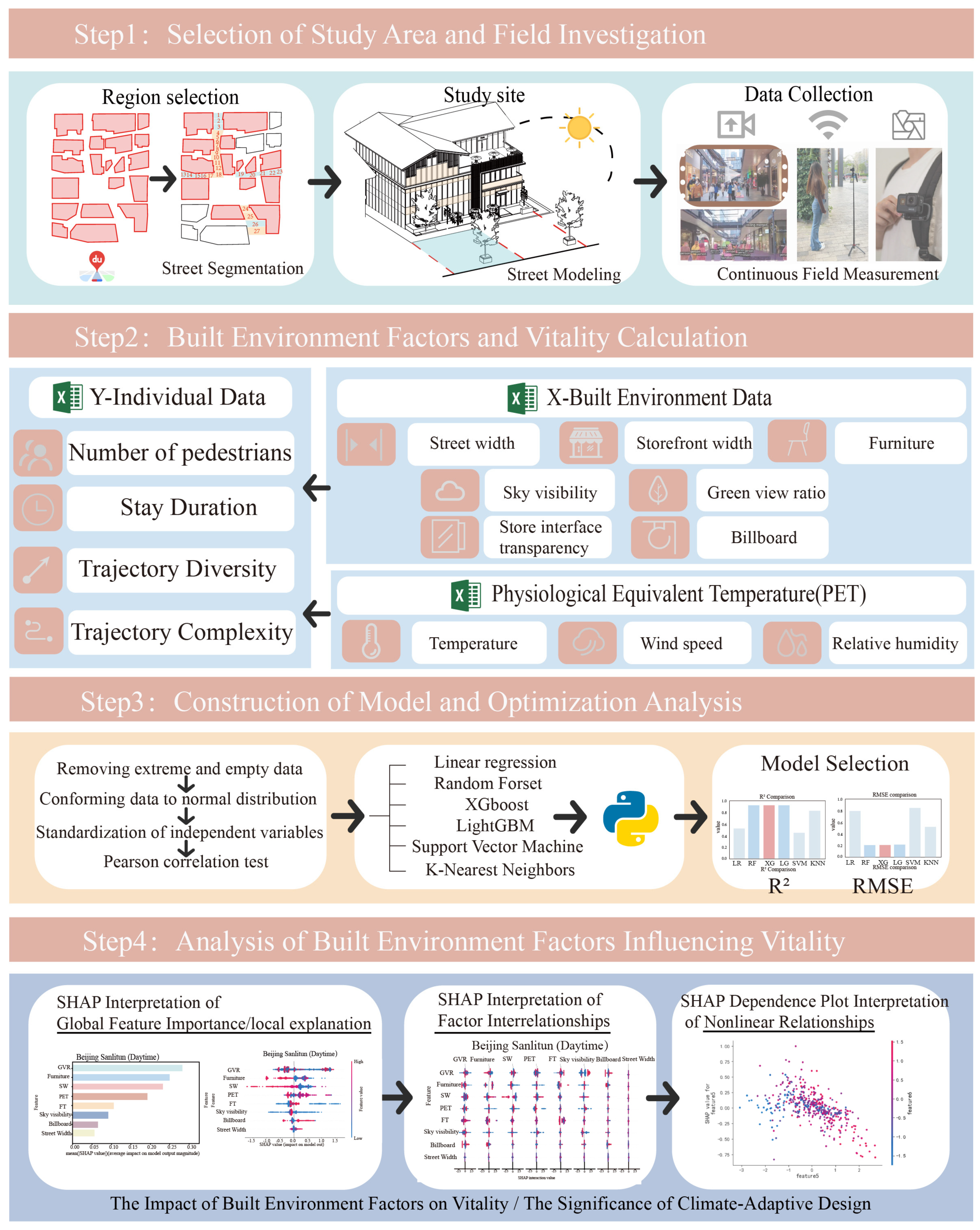
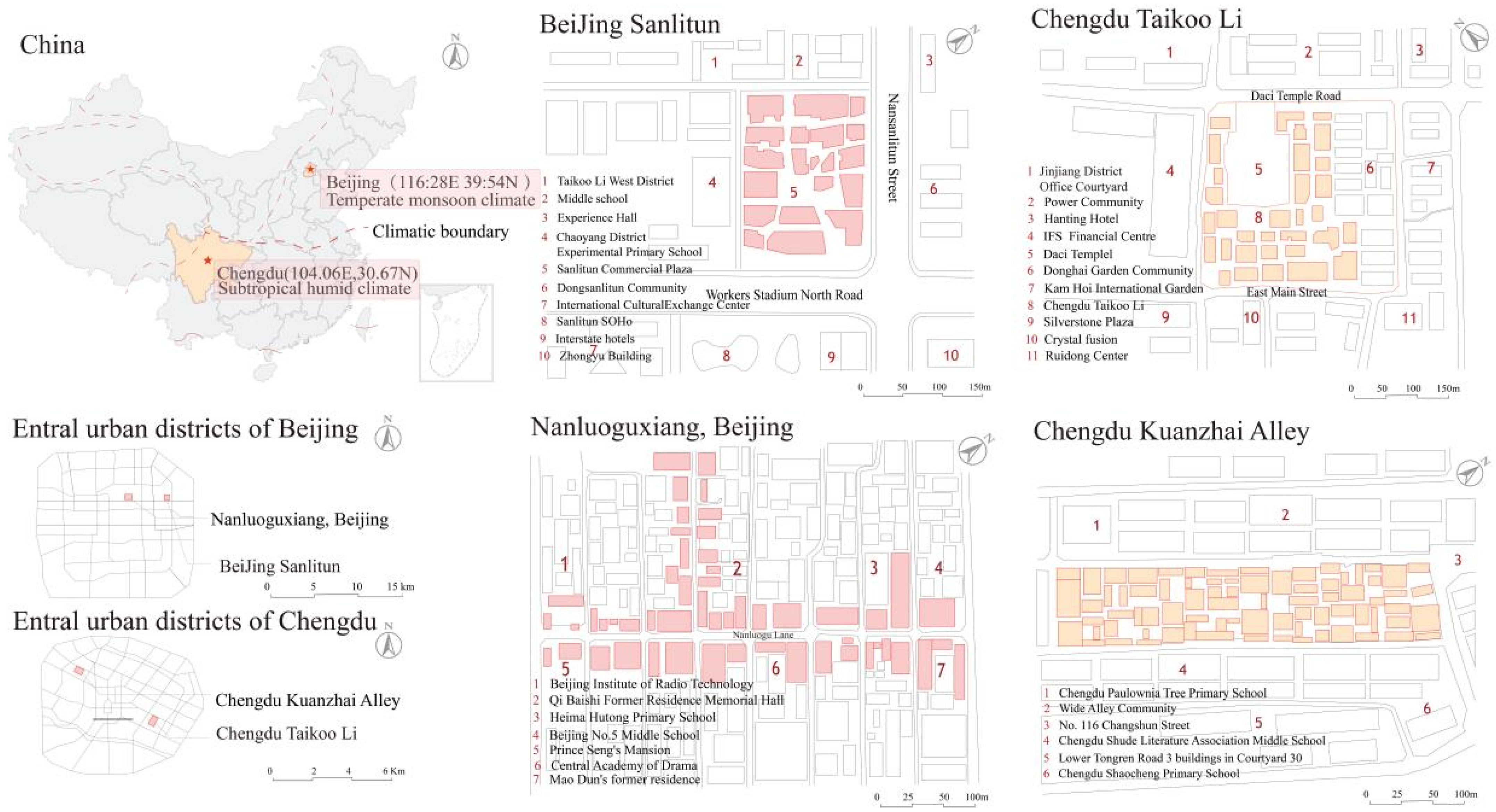
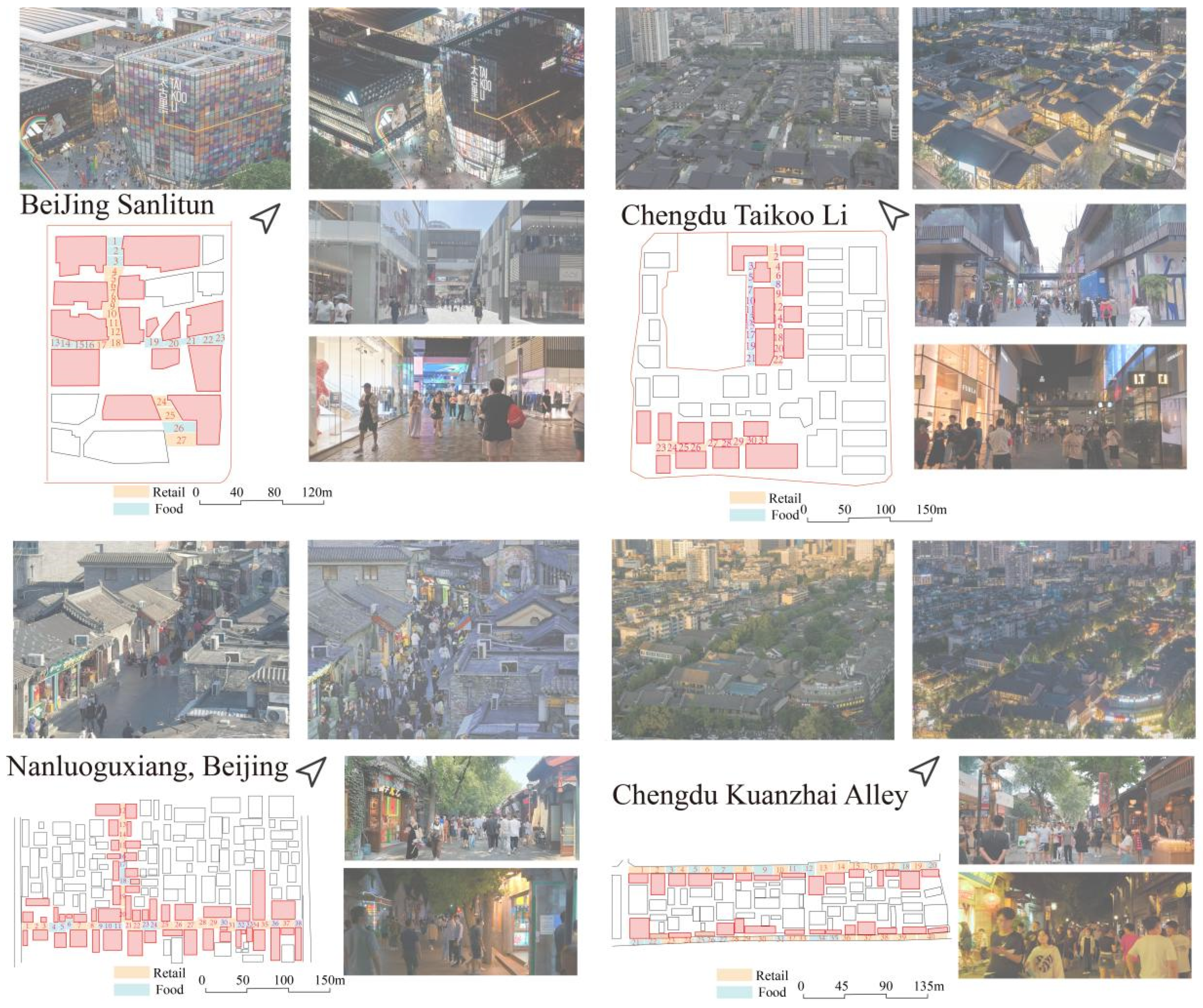

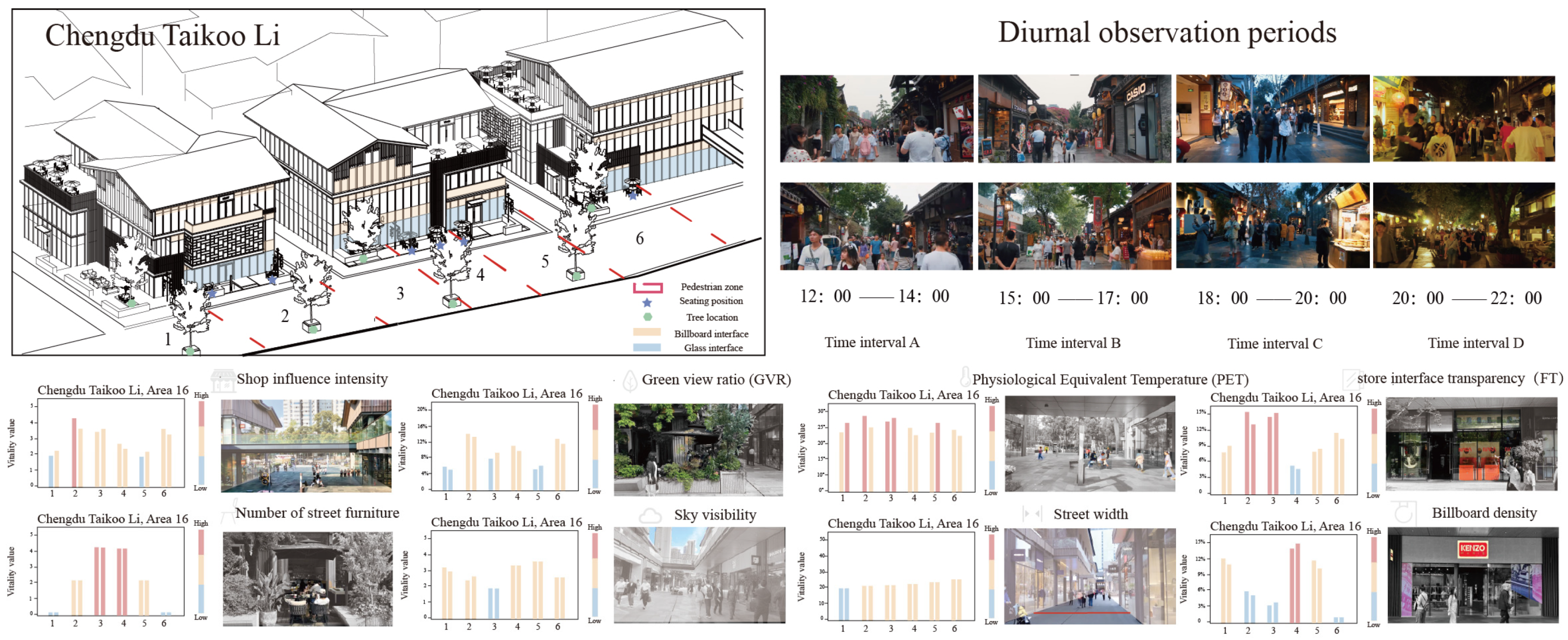
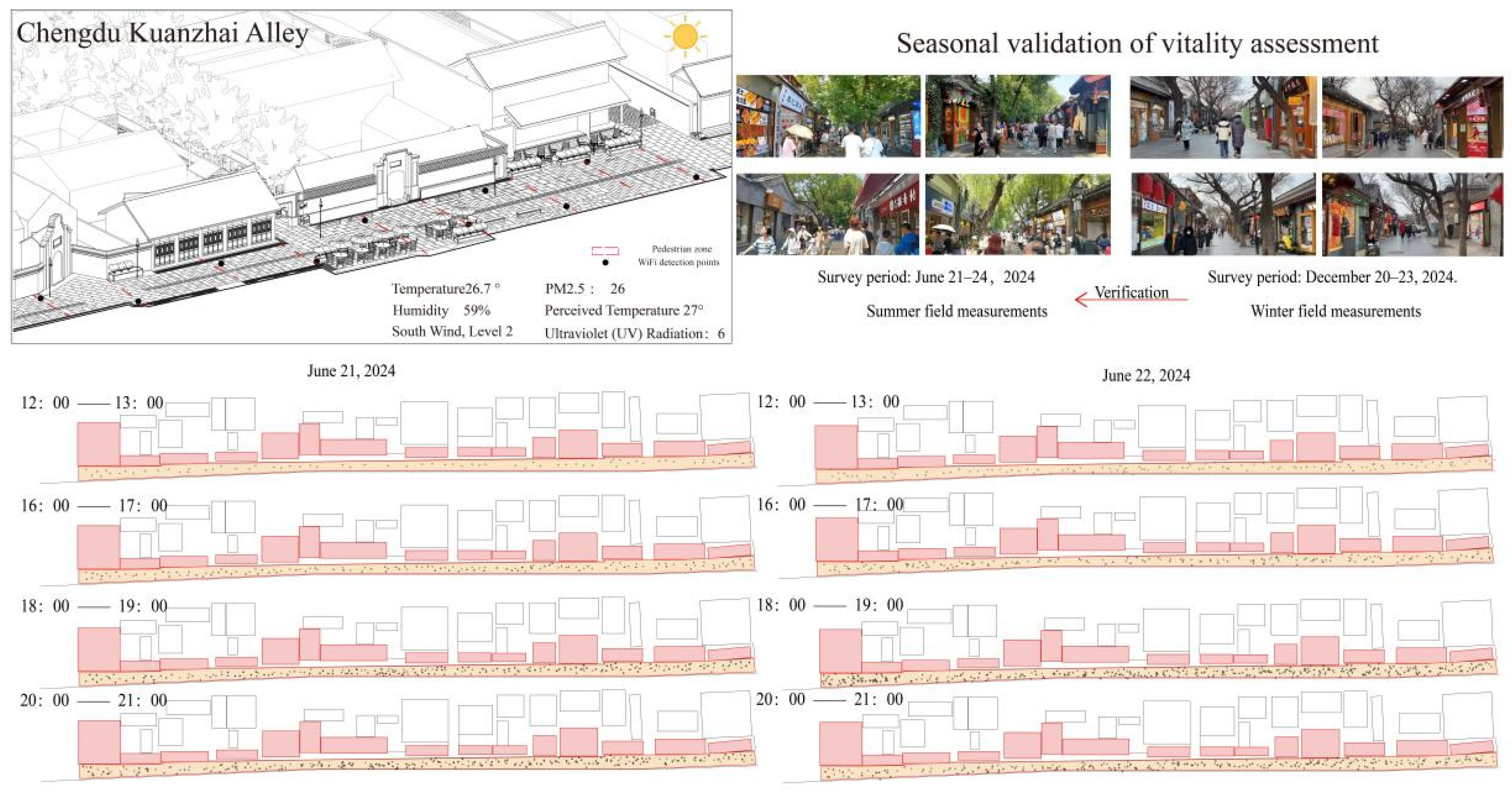

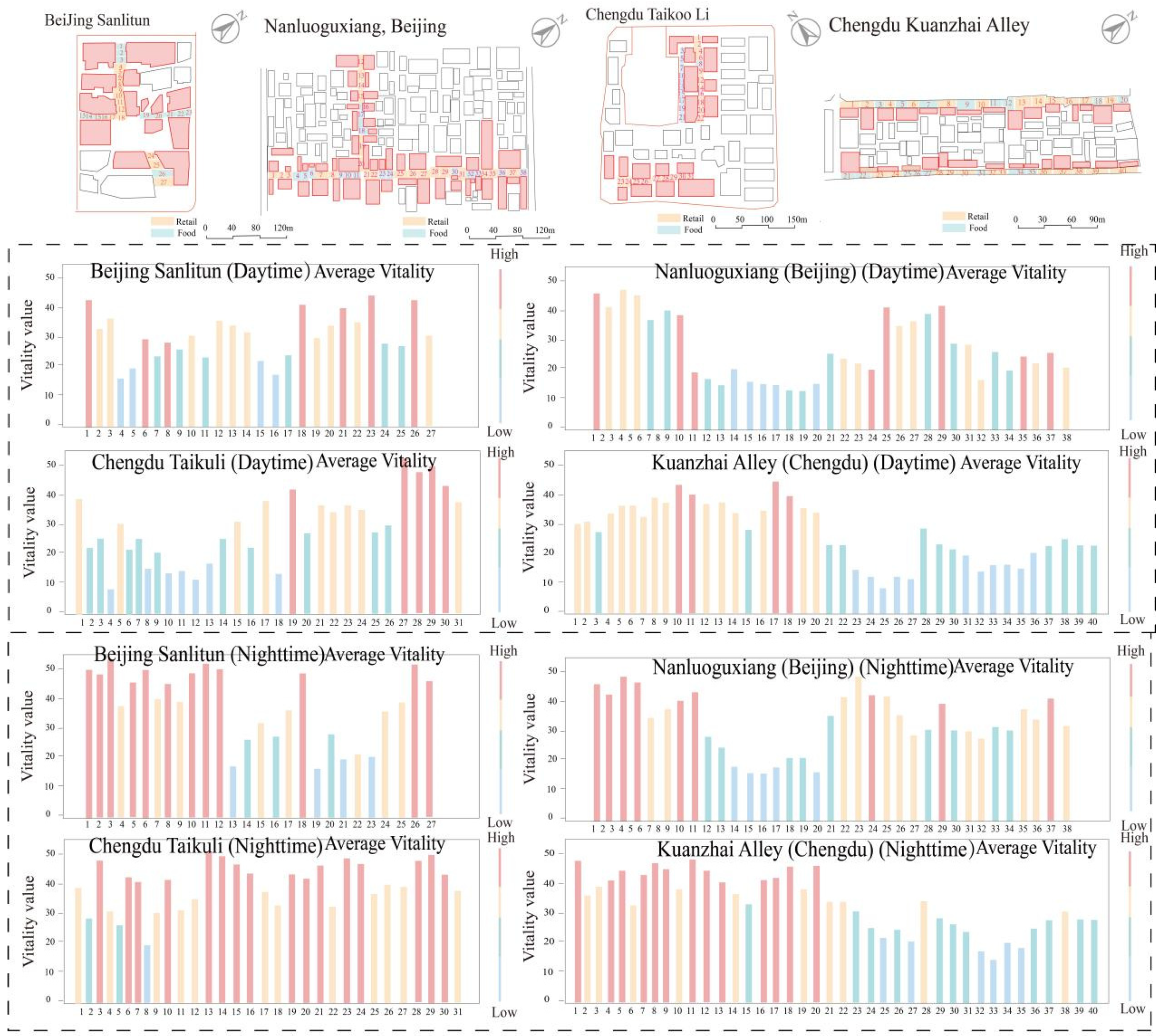


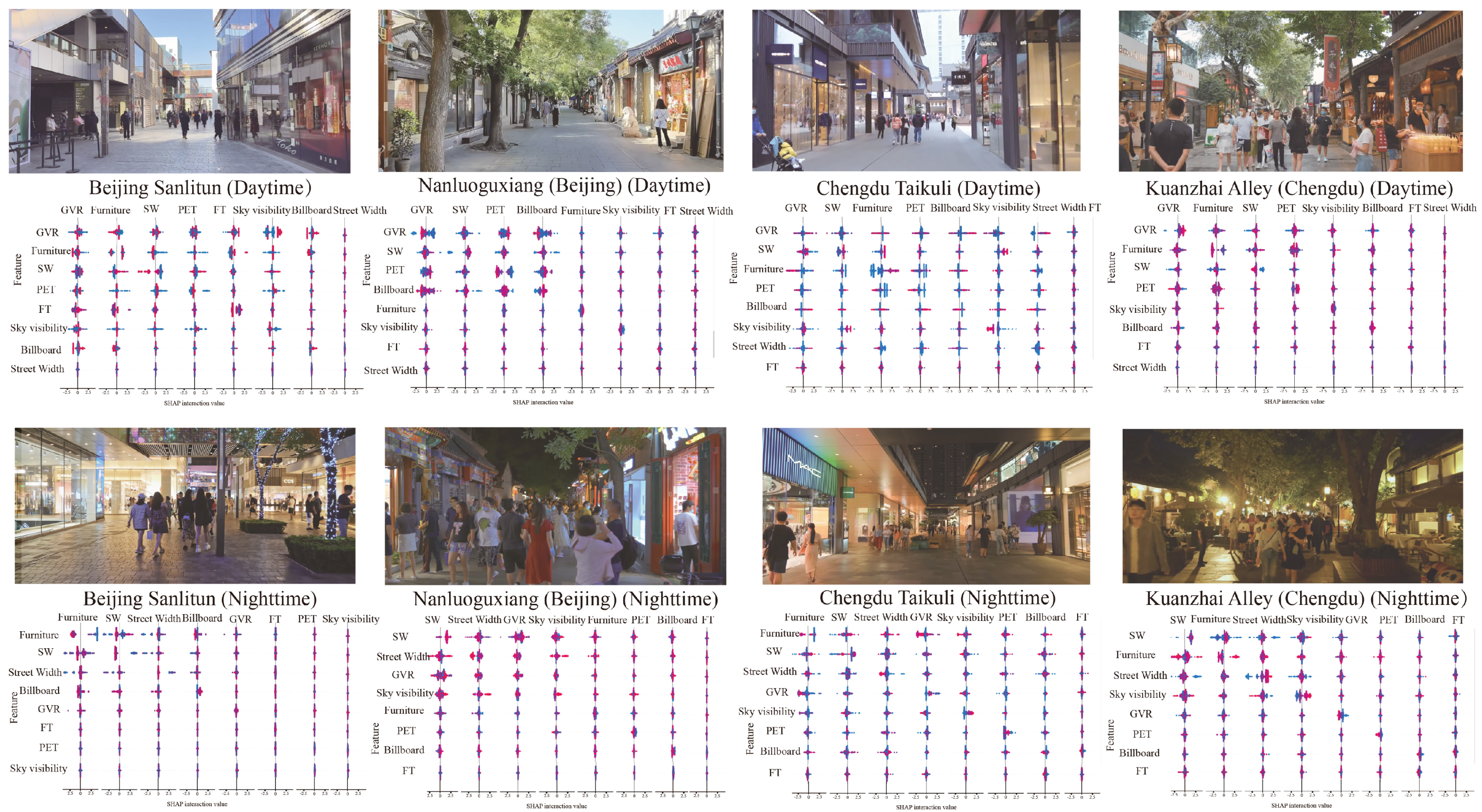
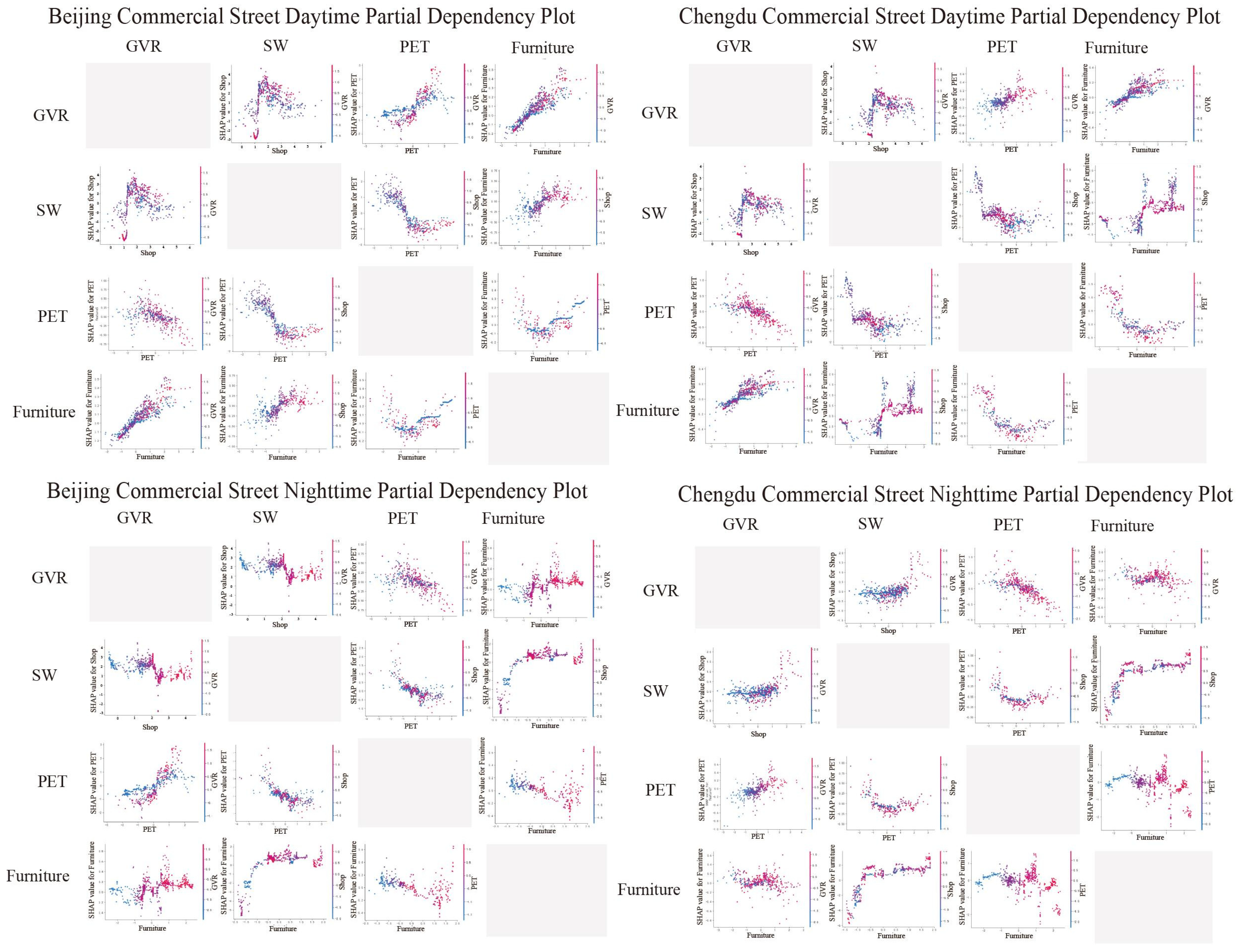
| Spatial Element Indicators | Calculation Method | Sources |
|---|---|---|
| Shop width (SW) | () storefront width of shop i, () total street-facing frontage of all shops on one side of shop i, () street-facing width of the commercial street for shop i. | Data for storefront lengths and commercial interface length from field measurement of the commercial pedestrian streets under study, or from architectural plans/drawings of the street and shop units. |
| Street width | () Street width of pedestrian commercial street area i, () total area of pedestrian commercial street area i, () street length of pedestrian commercial street area i. | Total street area come from urban planning GIS data, or be calculated via field-measured length and width (if regular shape), length of the line connecting midpoints of entrances/exits from field measurement or spatial mapping tools. |
| Green view ratio (GVR) | (GVR) green view ratio, () area of greenery in the pedestrian’s field of view, () total visual area in the pedestrian’s field of view. | Street view image segmentation algorithms, street view images from on-site photography (using cameras to capture pedestrian-level views of the street) or from existing street view datasets (e.g., Google Street View). |
| Sky visibility | (GVR) sky visibility, () area of the sky in the pedestrian’s field of view, () total visual area in the pedestrian’s field of view. | Relying on street view image segmentation algorithms. Street view images from on-site capture or existing street view data sources. |
| Number of items of street furniture | (N) number of items of street furniture in the pedestrian’s field of view, () the piece of street furniture, (M) total number of street furniture in the pedestrian’s field of view. | Street view image recognition algorithms (involve object detection models like YOLO, trained to identify street furniture types), street view images from on-site photography or existing datasets. |
| Physiological equivalent temperature (PET) | (PET) physiological equivalent temperature, an indicator of thermal comfort, (T) air temperature (°C), (RH) relative humidity (%), (WS) wind speed (m/s), (M) human metabolic rate (typically standardized to a sedentary state, ~80 W/m2), (R) radiant heat exchange (including solar and long-wave radiation, W/m2), (C) clothing thermal resistance (typically set at 0.5 clo for summer). | Air temperature, humidity, wind speed data from meteorological stations (either local fixed stations near the study area or mobile weather sensors deployed in the field). ENVI-met software (with input data from the aforementioned meteorological factors and possibly 3D models of the street environment built from architectural and urban data). |
| Store interface transparency (FT) | (FT) sore interface transparency, () area of transparent shop interfaces in the pedestrian’s field of view, () total visual area in the pedestrian’s field of view. | Street view image segmentation algorithms. Street view images from on-site capture (pedestrian-level photos of storefronts) or existing street view resources. |
| Billboard density | (BD) billboard density, () area of billboards in the pedestrian’s field of view, () total visual area in the pedestrian’s field of view. | Street view image segmentation algorithms, street view images from on-site photography or existing street view datasets. |
Disclaimer/Publisher’s Note: The statements, opinions and data contained in all publications are solely those of the individual author(s) and contributor(s) and not of MDPI and/or the editor(s). MDPI and/or the editor(s) disclaim responsibility for any injury to people or property resulting from any ideas, methods, instructions or products referred to in the content. |
© 2025 by the authors. Licensee MDPI, Basel, Switzerland. This article is an open access article distributed under the terms and conditions of the Creative Commons Attribution (CC BY) license (https://creativecommons.org/licenses/by/4.0/).
Share and Cite
Zhang, J.; Li, X.; Lian, H.; Li, H.; Zhang, J. Day–Night Synergy Between Built Environment and Thermal Comfort and Its Impact on Pedestrian Street Vitality: Beijing–Chengdu Comparison. Buildings 2025, 15, 2118. https://doi.org/10.3390/buildings15122118
Zhang J, Li X, Lian H, Li H, Zhang J. Day–Night Synergy Between Built Environment and Thermal Comfort and Its Impact on Pedestrian Street Vitality: Beijing–Chengdu Comparison. Buildings. 2025; 15(12):2118. https://doi.org/10.3390/buildings15122118
Chicago/Turabian StyleZhang, Jinjiang, Xuan Li, Haitao Lian, Haozhe Li, and Junhan Zhang. 2025. "Day–Night Synergy Between Built Environment and Thermal Comfort and Its Impact on Pedestrian Street Vitality: Beijing–Chengdu Comparison" Buildings 15, no. 12: 2118. https://doi.org/10.3390/buildings15122118
APA StyleZhang, J., Li, X., Lian, H., Li, H., & Zhang, J. (2025). Day–Night Synergy Between Built Environment and Thermal Comfort and Its Impact on Pedestrian Street Vitality: Beijing–Chengdu Comparison. Buildings, 15(12), 2118. https://doi.org/10.3390/buildings15122118









